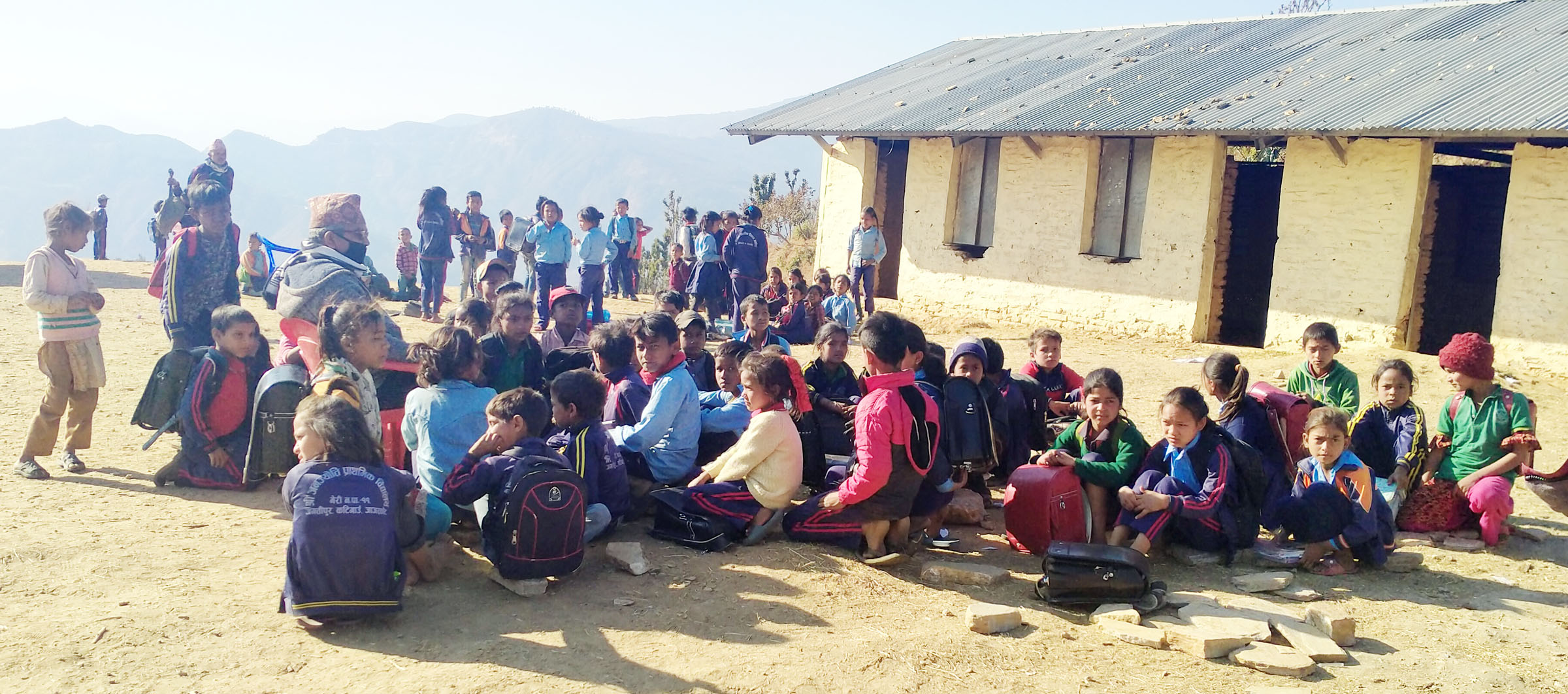
-Bishnu Nepal/RSS
KATHMANDU: Girl students’ attendance rate at Namuna Bhairav Secondary School based in Chhato of Kedar-Syun rural municipality in Bajhang has become almost hundred percent in the recent past years. Girls make up above fifty per cent of the total number of students of the school that stands at 800.
“Girls rarely miss schools even during menstruation. Schools provide them with sanitary pads. They do not skip classes on sexual and reproductive health and do not hesitate to consult with their peers and teachers in case of any confusion and issues about sexual and reproductive health,” said Samit Raj Giri, the chair of school management committee.
The school was the first in the district to launch the ‘adolescents-friendly information corner (AFIC)’ with the financial and technical support of the United Nations Population Fund (UNFPA) some years back.
The AFIC provides students with handbooks and other informative materials about sexual and reproductive health and comprehensive sexuality education (CSE).
In addition, an increasing awareness on reproductive health has also contributed to discouraging marriage before the age of 20 and minimizing the incidents of gender-based violence. Not just that, adolescents have developed confidence to be vocal against harmful practices and put forth their opinion.
Guardians/parents seem aware of the sexual and reproductive health rights of the children, according to Giri. “Teachers too feel comfortable to discuss about CSE with the students, unlike in the past.”
Dan Bahadur Rana, a subject teacher for health, population and environment at the Patan municipality-based Gyaneshwor Secondary School in Baitadi said, “In my case, the subject is no more hesitating.
Students too put their queries about sexual and reproductive health openly.” He had a coordinating role to set up the AFIC in the school five years ago and some training on the issue boosted his confidence to teach and talk about the topic without any hesitation.
There are 230 female students out of the total 525 in the school. “Earlier, I would think if I could escape the class on comprehensive sexuality education. No female student would appear in the most of the classes. A few appearing occasionally seem offended while attending the class,” Rana shared.
With the launching of the center some five years back, the situation took a new turn gradually. A significant improvement has been seen in the girls’ absence ratio and the cases of early marriage and GBV have dropped.
The World Health Organisation (WHO) identifies individuals who fall in the 10-19 age group as adolescents. The latest national demographic health survey shows that 28 percent girls are married when they are in the 15-19 age group. Similarly, 38.4 percent women are married before they reach 18 and 17 percent adolescent women of age 15-19 have already entered motherhood or are pregnant with their first baby.
Similarly, the conceiving rate among girls under 19 is 81 per 1,000.
A survey reveals that one in five women in the 15-49 age group suffer physical violence and one in four married women are subjugated to spousal violence ranging from physical, sexual to emotional abuses. Likewise, 31 percent of male respondents believe that wife battering is okay if they (wives) are disobedient to their husbands.
Sixty six percent of survivors are found not trying to resist or fight back the violence or seek help from anyone/anywhere else for its prevention.
UNFPA Baitadi programme coordinator Ganesh Shahi highlighted the need and significance of CSE to discourage the trend of pre-mature conceiving, early marriage, combating gender-based violence and to enhance access of adolescents to sexual and reproductive health services.
“Hence, the UNFPA is supporting to establish adolescents-friendly information center at schools, providing basic training on comprehensive sexuality education for subject teachers, sathi or friend teachers’ training, advocate for comprehensive sexuality education at local levels and ensuring availability of adolescent-friendly health services among others,” he said.
Government prioritises comprehensive sexuality education
The Ministry of Education, Science and Technology has said that it will be incorporating the comprehensive sexuality education in the proposed Education Sector Plan (2021-2030).
Recognising the role and contribution of the comprehensive sexuality education in minimizing child marriage, maternal mortality ratio and the GBV cases, which remain as hurdles to the social-economic development, the government is to promote the sexuality education.
The School Sector Development Plan (2073-2078 BS) which is coming to a close at the end of the current fiscal year has also incorporated the issues of comprehensive sexuality education.
Ministry joint secretary Dr Tulasi Thapaliya said the topic would be incorporated in the proposed education sector plan as the government seeks to achieve better results from the sexual and reproductive health education.
As the UNFPA says the CSE provides a full range of information, life skills and values to enable young people to make informed choices about their health and sexuality. It enables young people to protect and advocate for their health, well- being and dignity by providing them with a necessary toolkit of knowledge, attitude and skills.
It is defined as a precondition for exercising full bodily autonomy.
In overall, CSE has appeared as an integrated programme capable of leaving multi-dimensional ripple effects in the present context. Individuals mainly from 5 to 18 years of age are identified as the people who primarily need the CSE commensurate to their age.